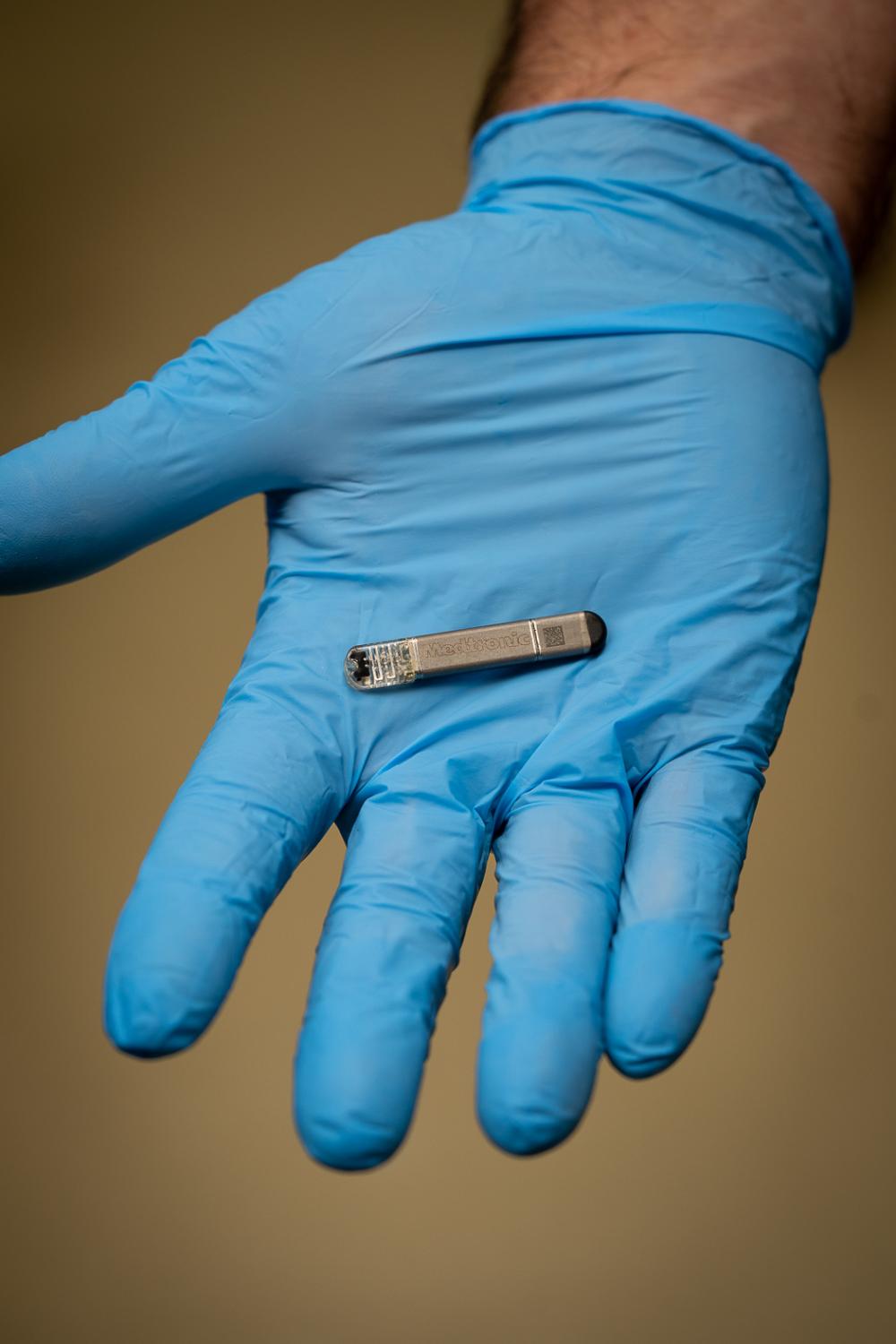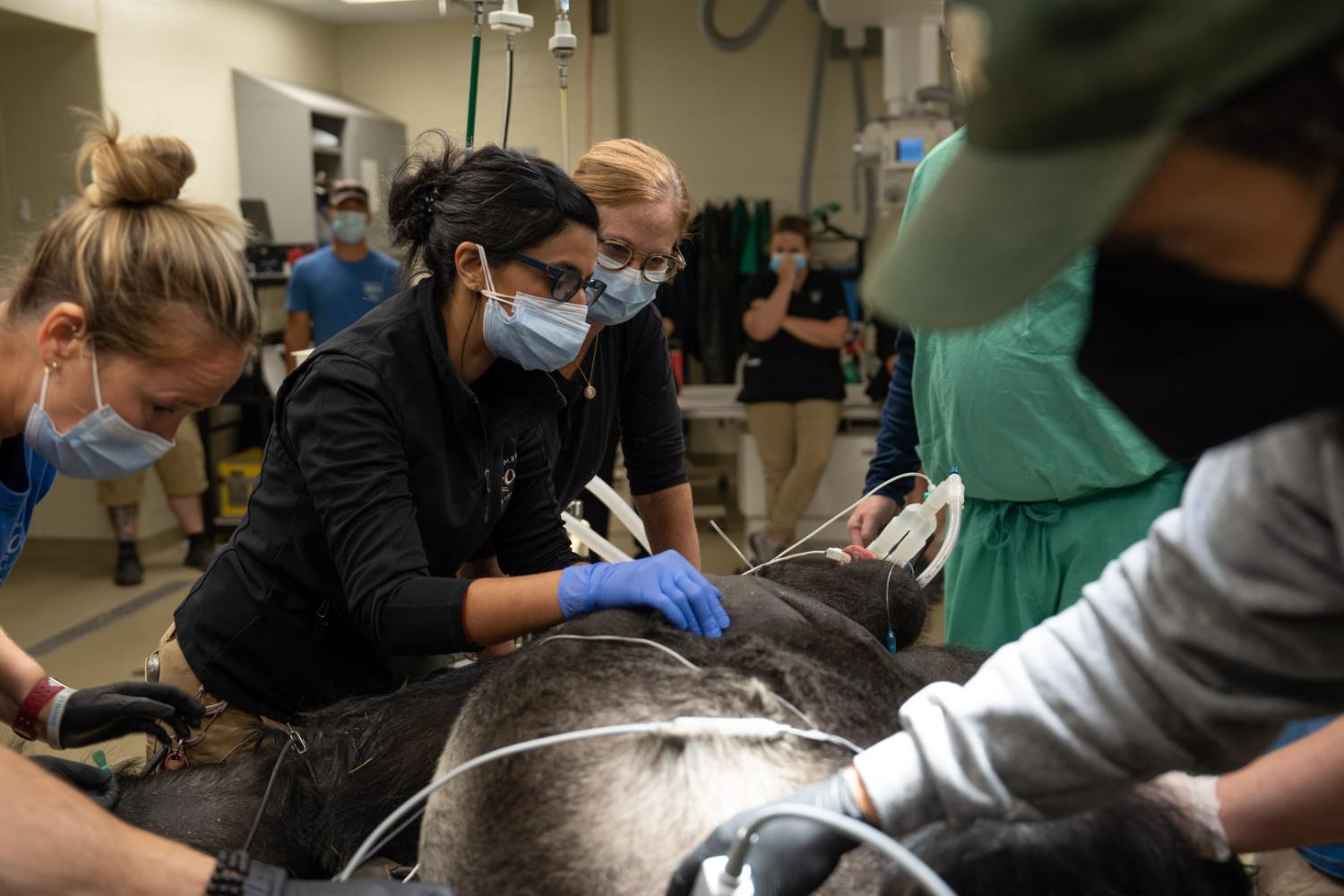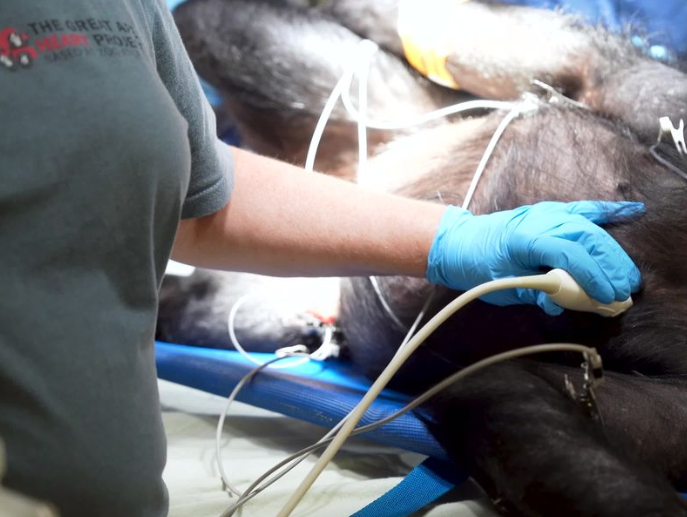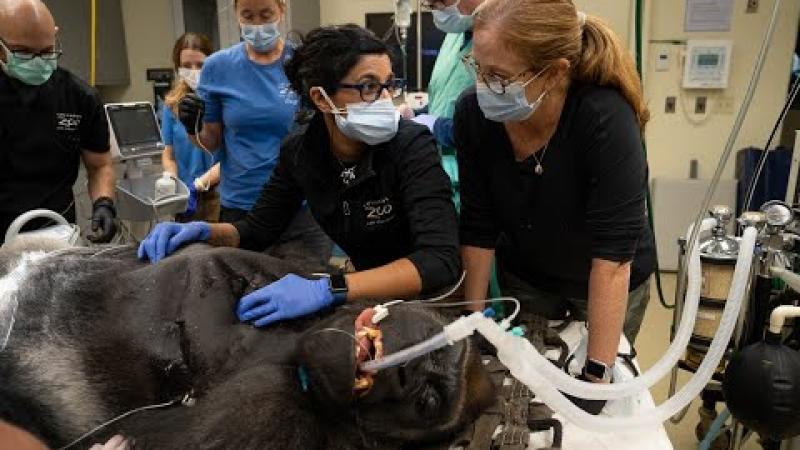The Columbus Zoo and Aquarium is extending the lives of six great apes suffering from heart disease with the help of cardiac monitors.
Here, we'll keep you updated on their progress! Scroll down to see the timeline of accomplishments.
OCTOBER 2022
Six great apes with progressive heart disease – including, for the first time anywhere, two bonobos, a species that shares over 98 percent of the same DNA as humans – were successfully implanted with insertable cardiac monitors (ICMs) at the Columbus Zoo and Aquarium to help extend their lives.
The Zoo brought together top medical and veterinary professionals to perform the procedures over three days on orangutans, bonobos, and gorillas. A cardiologist and an anesthesiologist – who usually treat people – joined Columbus Zoo veterinarians and experts from the Great Ape Heart Project, based at the Detroit Zoo {tag}, to implant a small cardiac monitor, a device about one-third the size of a AAA battery, into the apes’ chests. Following the procedure, they quickly returned to their habitats.
The cardiac monitors were generously donated by Medtronic, are smaller than the size of an AAA battery, and are the same ones used to monitor human cardiac activity. They track the apes for signs of irregular heartbeats, called arrhythmias, and then upload the data to the Great Ape Heart Project’s database. Experts there are monitoring the data in real time and will alert Columbus Zoo veterinarians to any abnormalities so the apes can be treated with medications or other procedures.
“These procedures have been a breakthrough for these six individual great apes, but the cardiac monitors also provide critical knowledge to advance veterinary care for their species,” said Dr. Priya Bapodra-Villaverde, Columbus Zoo senior veterinarian and executive committee member of the Great Ape Heart Project. “The coordination and commitment required has been staggering, and it shows just how much every professional – whether a doctor or a veterinarian or the caregivers who see these animals every day – are devoted to the health of these animals.”
The six apes that received the cardiac monitors are experiencing the same type of health problems affecting humans: high blood pressure, and similar cardiac issues. They include male bonobos, orangutans, and silverback gorillas.
“It’s remarkable how similar the hearts of these species are to those of human patients,” said cardiologist Dr. Ilana Kutinsky from the Great Ape Heart Project. “It means we can use similar treatments we apply to our human patients. Tracking the heart rhythms of these orangutans, bonobos, and gorillas provides the Zoo’s veterinarians critical information about how to best manage any cardiac issues that arise.”

The Columbus Zoo’s animal care experts work with the great apes regularly to help them actively participate in their own veterinary care, whether they’ve been diagnosed with cardiac issues or are simply older and have a higher chance of developing them.
Dr. Marietta Danforth, Great Ape Health Project director, said she is grateful for the team of medical and veterinary experts who collaborated to complete a half dozen implantations in just three days.
“Coming together and extending the cardiac care network is exactly what’s needed to help these great apes—whose cardiac health issues can often go undetected in the earlier stages just as in humans—live longer, healthier lives,” Danforth said.

APRIL 2023
With months of implanted cardiac monitor data of their belts, the Animal Health and Animal Care teams continue to monitor each ape’s heart functionality and condition. Each animal is monitored weekly for heart rates and any changes that the implants may detect.
“We are finally in the groove of pulling data off of the implants and aren’t seeing any significant changes or concerns in any of the animals,” said Dr. Priya Bapodra-Villaverde. “We are sharing all of our reports with the Great Ape Heart Project. We also want to recognize the zookeepers for their hard work in this project! They’ve trained specifically for this project to obtain ape blood pressures, ECG readings from the implanted devices, and retrieve blood collections…They’ve done great work.”

Like with humans, the location of each device has shifted within each ape over time. Because of that, each ape needs to be in a unique position so keepers can collect the weekly data, and they are trained to do so voluntarily.
“Once the initial incision healed, it was virtually impossible to see the device from the outside in the gorillas and orangutans,” said Audra Meinelt, Curator for the Congo Expedition at the Columbus Zoo. “In the orangutans, the implants are hidden under the throat sac and require them to turn their heads to the side while pushing up their chests, and we can then get a great reading. For Ktembe, a gorilla in our care, the implant has moved upward a bit so we need him to raise his chin up while device data is accessed.”
The bonobos are a bit easier. “Since they don’t have as much space between the skin and muscle, the readings are the easiest to obtain,” Meinelt said. “Because their chests are a bit easier to push flush to the mesh, readings are easier and the bonobos remain comfortable throughout the assessment.”

October 2023
"These devices continue to be game changing – although we had the ability to monitor ECGs at various intervals with training, this continual monitoring is providing invaluable information about how heart rates change overnight, when changes in heart rhythms ae more likely to occur, and their overall cardiac health, said Dr. Priya Bapodra-Villaverde, Senior Veterinarian for the Columbus Zoo and Aquarium. "Of course it provides just one piece of the puzzle in addition to awake blood pressures, heart scans and labwork. But we are monitoring these animals the best we can, and together all of this information allows us to make adjustments to their cardiac medications, keeping them as healthy as possible for as long as possible."
What we've learned:
- We are continuing to evaluate animals both here at the Zoo and at other facilities that may fit the criteria to have an ILR placed. Additional bonobos at the Zoo have been identified that would benefit from having more advanced cardiovascular monitoring. In addition, ILR data from other animals around the nation are being incorporated into health studies to determine how management strategies can affect overall wellbeing.
- Bonobo Maiko’s ILR was able to identify that his heart was no longer functioning well, and it provided objective data which the Zoo used to make a science and health-based decision about Maiko’s quality of life while in cardiac failure. We are continuing to collect data on the frequency of abnormal heart rhythms, normal heart rates, and how appropriate placement affects how easy they are for the staff to read.
- Keepers have learned which locations allow the animals to find their most comfortable positions for presenting their chests for the duration of the IRL information download. Some of these sessions can be completed faster than others while others take a bit more finesse.
September 2024
We’re thrilled to share some incredible progress in the health and wellbeing of our bonobos! Recently, the Columbus Zoo’s Conservation Medicine team completed comprehensive cardiac evaluations for all the bonobos in our care, using advanced techniques like echocardiograms and CT scans. Thanks to our aggressive heart health program, we’ve not only managed cardiac disease, but have actually reversed structural heart changes in FIVE bonobos!
Dr. Priya Bapodra-Villaverde shared just how humbling it’s been to witness the positive changes in this special group of animals – some who have had cardiac issues for years: “We’ve been able to utilize the same tools that are available for human healthcare, and, thanks to the incredible training the Animal Care teams have done with all of the bonobos, including finger blood pressures measurements, ECG readings, awake heart scans and blood collections to monitor overall health while on medications, we’re seeing success. The voluntary participation of the bonobos has allowed us to obtain frequent cardiovascular data in these animals, allowing us to make real time accurate decisions with regards to medication and dose choice. In addition, four bonobos have been implanted with insertable cardiac monitors, thanks to a generous grant involving Medtronic and the Great Ape Heart Project, which allows us continually record heart rate and changes in heart rhythm.”
Check back for continuous updates on the Great Ape Heart Project.
In the meantime, learn more about the apes in our care at the Columbus Zoo and Aquarium in our Congo Expedition.










